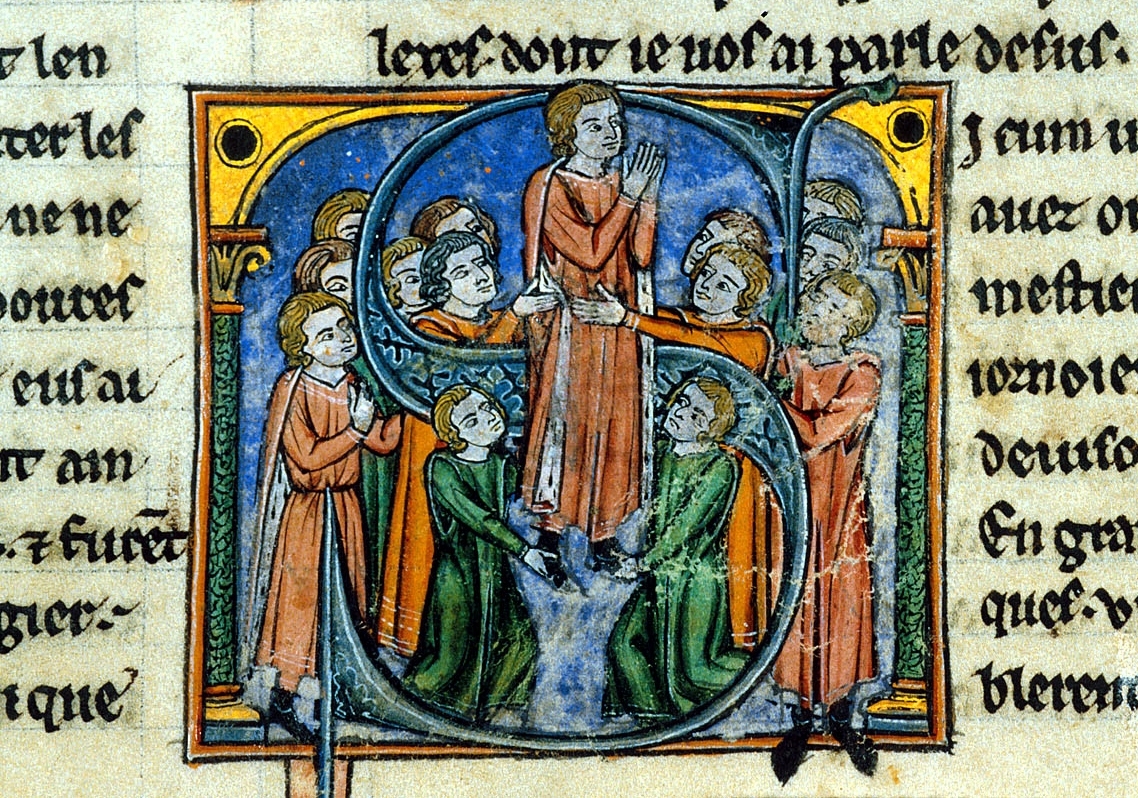Godfrey of Bouillon (French: Godefroy, Dutch: Godfried, German: Gottfried, Latin: Godefridus Bullionensis; 18 September 1060 – 18 July 1100) was a French nobleman and pre-eminent leader of the First Crusade. First ruler of the Kingdom of Jerusalem from Juy 22, 1099 to July 18,1100, he avoided the title of king, preferring that of princeps or Defender of the Holy Sepulchre.
Second son of Eustace II, Count of Boulogne, Godfrey became Lord of Bouillon in 1076 and in 1087 Emperor Henry IV confirmed him as Duke of Lower Lorraine, a reward for his support during the Great Saxon Revolt.
Along with his brothers Eustace III and Baldwin of Boulogne, Godfrey joined the First Crusade in 1096. A detailed account of the composition of Godfrey's army can be found here. Godfrey took part in actions at Nicaea, Dorylaeum and Antioch, before playing a key role during the capture of Jerusalem in 1099.
Once Jerusalem was conquered on July 15, 1099, some form of government had to be set up. On July 22, 1099, a council was held in the Church of the Holy Sepulchre and after Raymond of Toulouse had refused the crown, Godfrey agreed to become ruler. However, he preferred "Defender of the Holy Sepulchre" to that of king, allegedly refusing to "wear a crown of gold where his Saviour had worn a crown of thorns". Both the meaning and usage of his title is disputed; Advocatus Sancti Sepulchri or "Defender of the Holy Sepulchre", only appears in a letter not written by Godfrey, who seems to have used either the more ambiguous term Princeps, or his previous rank of duke. Robert the Monk is the only chronicler to suggest he took the title "king".
During his short reign, Godfrey had to defend the new kingdom against the Fatimids of Egypt, who were defeated at the Battle of Ascalon on August 12, 1099. He also faced opposition from Dagobert of Pisa, the Latin Patriarch of Jerusalem, who was allied with Tancred. Tancred was an Italo-Norman leader of the First Crusade who later became Prince of Galilee and regent of the Principality of Antioch. Tancred came from the house of Hauteville and was the great-grandson of Norman lord Tancred of Hauteville.
Although the Latins came close to capturing Ascalon, Godfrey's attempts to prevent Raymond of St. Gilles from securing the city for himself meant that the town remained in Muslim hands, destined to be a thorn in the new kingdom's side for years to come.
In 1100, Godfrey was unable to directly expand his new territories through conquest. However, his impressive victory in 1099 and his subsequent campaigning in 1100 meant that he was able to force Acre, Ascalon, Arsuf, Jaffa, and Caesarea to become tributaries. Meanwhile, the struggle with Dagobert continued, although the terms of the conflict are difficult to trace. Dagobert may well have envisaged turning Jerusalem into a fiefdom of the pope, but his full intentions are not clear. Much of the evidence for this comes from William of Tyre, whose account of these events is troublesome; it is only William who tells us that Dagobert forced Godfrey to concede Jerusalem and Jaffa, while other writers such as Albert of Aachen and Ralph of Caen suggest that both Dagobert and his ally Tancred had sworn an oath to Godfrey to accept only one of his brothers or blood relations as his successor.
Whatever Dagobert's schemes, they were destined to come to naught. Being at Haifa at the time of Godfrey's death, he could do nothing to stop Godfrey's supporters, led by Warner of Grez, from seizing Jerusalem and demanding that Godfrey's brother Baldwin should succeed to the rule. Baldwin of Boulogne (1060s – 2 April 1118), was the first count of Edessa from 1098 to 1100. Dagobert was subsequently forced to crown Baldwin as the first Latin king of Jerusalem on December 25, 1100. Baldwin ruled als Baldwin I until his death in 1118.
This blog quotes adapted text from the Wikipedia pages on Godfrey, Tancred and Baldwin I. The illustration shows detail of an historiated initial 'S'(i cum) of Godfrey of Bouillon being created the Lord of the city, Date 13th century, Source British Library Manuscript in the Yates Thompson Collection (No. 12, f. 46) [1]. From Histoire d'Outremer by William of Tyre. (Public Domain)
Support TemplarsNow™ by becoming a Patron, tipping us or buying one of our Reliable Books

1 comment:
Excelentes artículos. Deseo continuar recibiéndolos. Muchas gracias
Post a Comment